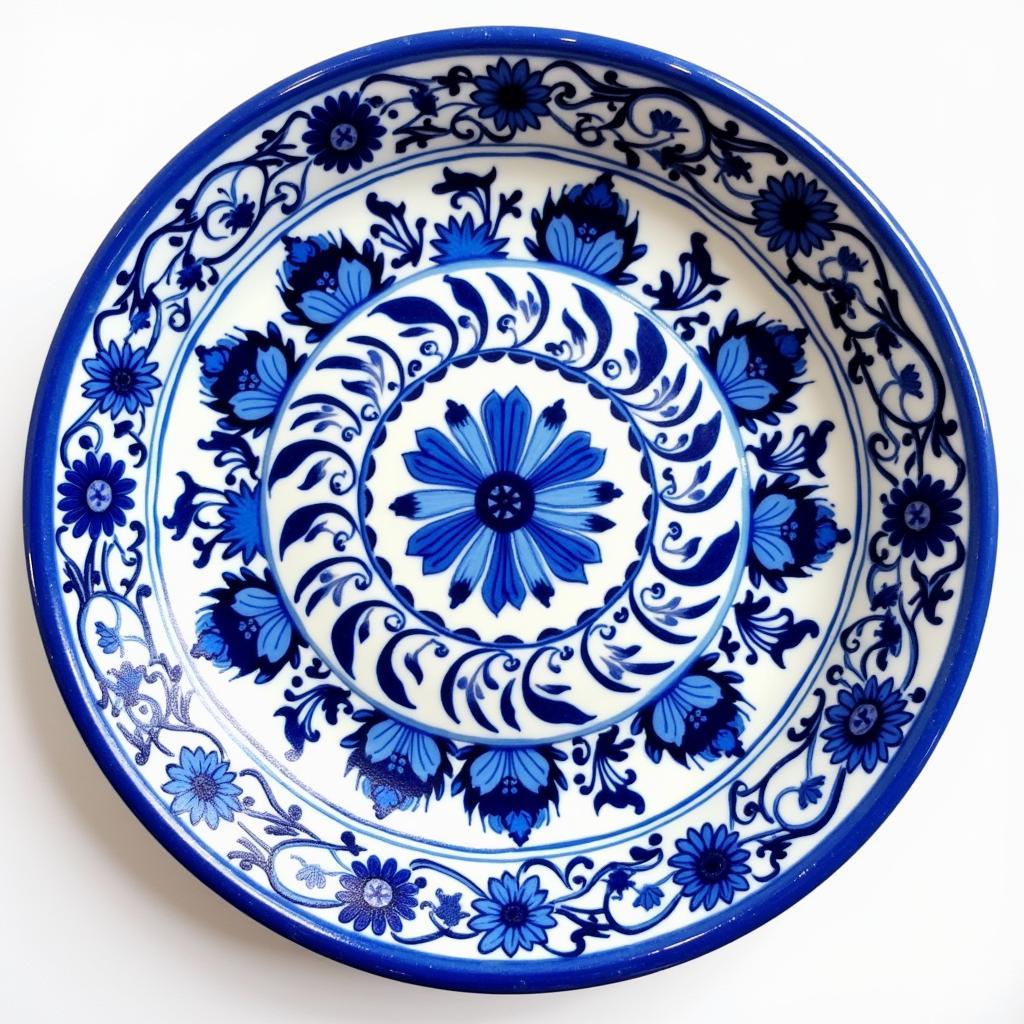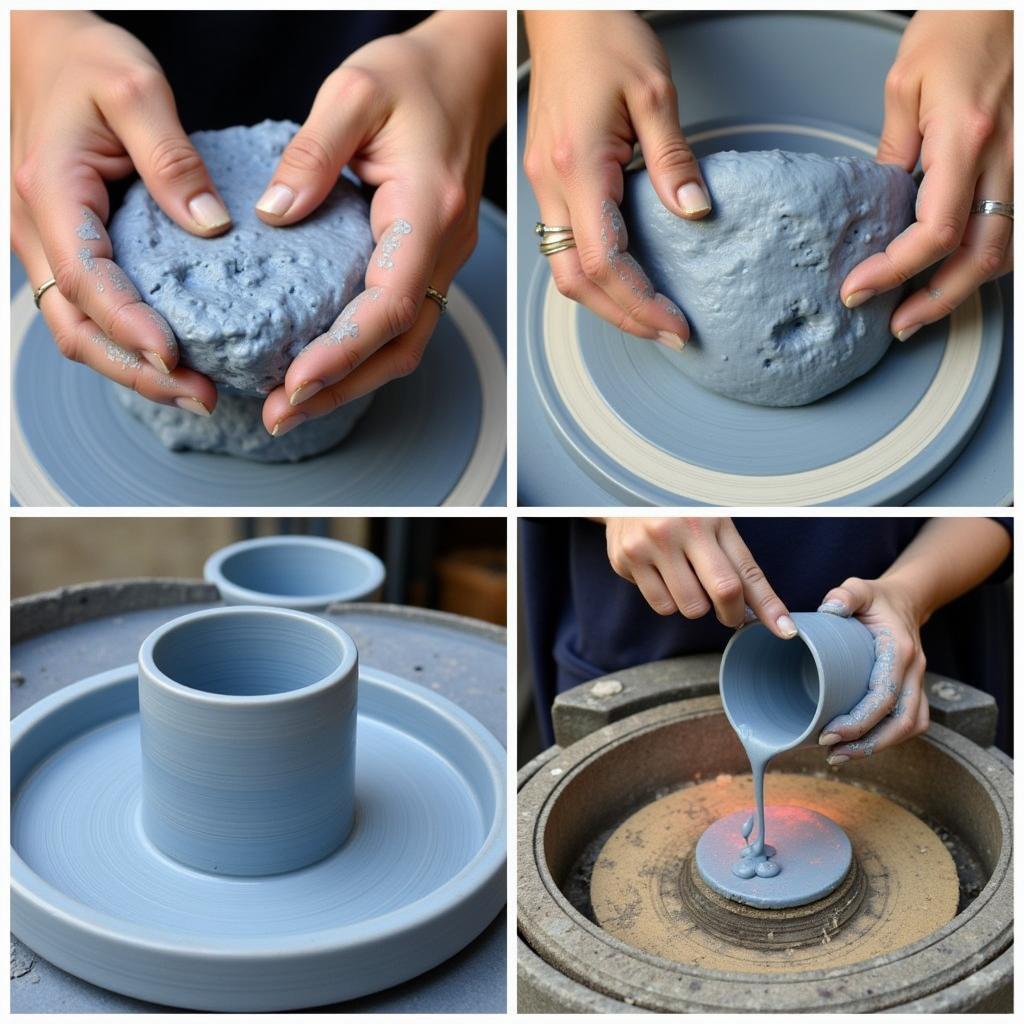The mesmerizing Blue Pottery Of Pakistan, a craft steeped in history and tradition, has captivated artisans and art enthusiasts for centuries. From its Persian origins to its unique evolution in the Pakistani landscape, this vibrant art form reflects a rich cultural heritage and continues to thrive today.  Traditional Blue Pottery Designs of Pakistan
Traditional Blue Pottery Designs of Pakistan
A Journey Through Time: The History of Blue Pottery of Pakistan
Blue pottery, also known as Kashikari, arrived in the Indian subcontinent through Persian influences, eventually finding a permanent home in Multan, Pakistan. The city’s unique soil composition, rich in Multani mitti (fuller’s earth), proved ideal for crafting these exquisite pieces. Over the centuries, Pakistani artisans developed their own distinct style, incorporating local motifs and techniques that set their work apart. pottery of pakistan This evolution has led to a captivating blend of Persian heritage and Pakistani ingenuity.
The Art of Creation: Crafting Blue Pottery
The process of creating blue pottery is a labor of love, requiring patience, skill, and a deep understanding of the materials. Unlike other ceramic techniques, blue pottery doesn’t involve the use of conventional clay. Instead, it relies on a quartz-based dough, which is meticulously molded and shaped.  The Making of Blue Pottery in Pakistan Once dried, the pieces are adorned with intricate designs using a cobalt blue pigment. This unique coloring process gives the pottery its signature vibrant hue. After glazing and firing, each piece emerges as a unique work of art.
The Making of Blue Pottery in Pakistan Once dried, the pieces are adorned with intricate designs using a cobalt blue pigment. This unique coloring process gives the pottery its signature vibrant hue. After glazing and firing, each piece emerges as a unique work of art.
What Makes Pakistani Blue Pottery Unique?
Pakistani blue pottery stands out due to its distinct characteristics. The use of quartz, the vibrant blue hues, and the intricate hand-painted designs all contribute to its unique aesthetic appeal. ceramic pots pakistan The traditional patterns often feature floral motifs, geometric shapes, and calligraphy, reflecting the rich cultural heritage of the region.
From Decorative Pieces to Everyday Objects: Uses of Blue Pottery
Blue pottery is not merely decorative; its functionality is woven into its artistic beauty. From intricately designed vases and plates to practical bowls and mugs, blue pottery adorns homes and adds a touch of elegance to everyday life. pakistan pottery The pieces are often used for serving food, storing spices, or simply adding a touch of artistic flair to a space.
“The beauty of blue pottery lies in its versatility,” explains renowned ceramic artist, Fatima Khan. “It seamlessly blends artistic expression with practical functionality, making it a cherished part of Pakistani culture.”
Where to Find Authentic Blue Pottery in Pakistan?
Multan remains the heart of blue pottery production in Pakistan. Visiting the city offers a chance to witness the craft firsthand and purchase authentic pieces directly from the artisans. Numerous workshops and studios throughout the city welcome visitors, providing a glimpse into the rich history and artistry of this unique craft.
Preserving a Legacy: The Future of Blue Pottery of Pakistan
While the craft faces challenges from mass-produced imitations, efforts are underway to preserve and promote this traditional art form. ceramic industry in pakistan Organizations and individuals are working to support local artisans, provide training opportunities, and raise awareness about the importance of preserving this cultural heritage. “It’s crucial that we continue to support the artisans who dedicate their lives to keeping this beautiful tradition alive,” says renowned art historian, Dr. Amir Ali.
In conclusion, the blue pottery of Pakistan stands as a testament to the country’s rich artistic heritage. From its historical roots to its contemporary evolution, this vibrant art form continues to enchant with its unique beauty and cultural significance. Supporting local artisans and appreciating the intricate craftsmanship ensures that this timeless tradition thrives for generations to come.
FAQ:
- What is blue pottery made of? Pakistani blue pottery is crafted using a quartz-based dough, unlike traditional clay.
- What gives blue pottery its distinct color? The signature blue hue comes from cobalt blue pigment.
- Where can I buy authentic blue pottery? Multan, Pakistan, is the hub for blue pottery production.
- Is blue pottery only decorative? No, it’s used for both decorative and functional purposes.
- How can I support the blue pottery industry? Purchase authentic pieces directly from artisans and promote the craft.
- What are the common patterns found on blue pottery? Floral motifs, geometric shapes, and calligraphy are common designs.
- Is blue pottery expensive? Prices vary depending on the size, intricacy, and the artist.
For further assistance, please contact us: Phone: +923337849799, Email: [email protected] or visit our office at Dera Ghazi Khan Rd, Rakhni, Barkhan, Balochistan, Pakistan. We have a 24/7 customer service team.